This hunting maneuver may not be quite as visually dramatic as the one featured in yesterday’s post but it was still a pretty neat trick.
1/5000, f/6.3, ISO 640, Canon 7D Mark II, Canon EF 500mm f/4L IS II USM + EF 1.4 III Extender, not baited, set up or called in
This is the same male Short-eared Owl as in yesterday’s post about one minute after his first failed attempt at a vole. He had returned to another nearby metal post to try again. Here he’s scanning the middle distance for any sign of voles or other potential prey in the tall grass between the road I was on and the pasture on the other side of the fence. The owl was obviously using both his highly tuned visual and hearing capabilities to pick up the sight and/or sound of rodents scurrying about in the long grass.
1/3200, f/6.3, ISO 640, Canon 7D Mark II, Canon EF 500mm f/4L IS II USM + EF 1.4 III Extender, not baited, set up or called in
Suddenly his attention was intensely focused on something in the grasses almost directly beneath him. I mean he was looking almost straight down! It’s my belief that he located this probable vole by sound rather than sight. The photographer in me immediately tried to visualize precisely how the bird would make an attack at such an incredibly steep angle so I had the best chance to keep him in frame as he launched.
Think about it. Voles are a furtive and incredibly quick quarry for both raptors and photographers (after all these years I still don’t have a decent photo of one and believe me I’ve tried…). The attack had to be fast, under power and very steep. How could the owl do that from a standing start when his body was pointed upwards but his quarry was almost straight down? I actually wondered if he might launch horizontally in another direction to gain speed and then make a quick, tight turn to come down on the vole.
1/2500, f/6.3, ISO 640, Canon 7D Mark II, Canon EF 500mm f/4L IS II USM + EF 1.4 III Extender, not baited, set up or called in
But he didn’t. In a flash he pointed his body almost straight down and apparently used his right foot to grasp the tip of the post and push against it for speed.
1/2500, f/6.3, ISO 640, Canon 7D Mark II, Canon EF 500mm f/4L IS II USM + EF 1.4 III Extender, not baited, set up or called in
From my other very blurry images taken after this shot I can tell he only had time for a single power stroke of his wings before he had to flare up so he could present his talons to the vole. I think this photo dramatically illustrates the very steep angle the bird had to launch under power. Just dropping down using only the force of gravity wouldn’t have generated enough speed to give him a reasonable chance at the vole.
And yes, I wish I hadn’t clipped that wing!
1/4000, f/6.3, ISO 640, Canon 7D Mark II, Canon EF 500mm f/4L IS II USM + EF 1.4 III Extender, not baited, set up or called in
Here’s where he landed. I include this shot in part to show you how close he was to the post he launched from and how steep the attack had to be (it’s a double post but one of them was longer than the other as you can see in the previous image).
This was another failed attempt – when he took off again his talons were empty.
But two minutes later another attack on a vole from a different metal post was successful and I was able to get a single blurry image of him carrying the little rodent to his presumed nest and chicks in the pasture on the other side of the road.
Persistence usually pays off eventually and I was delighted to see the owl finally succeed.
Ron


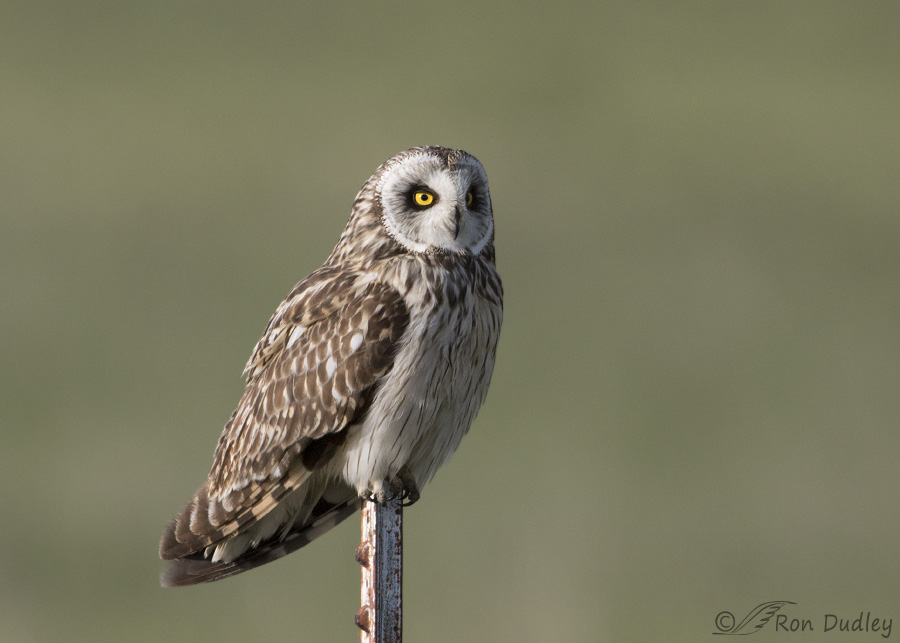
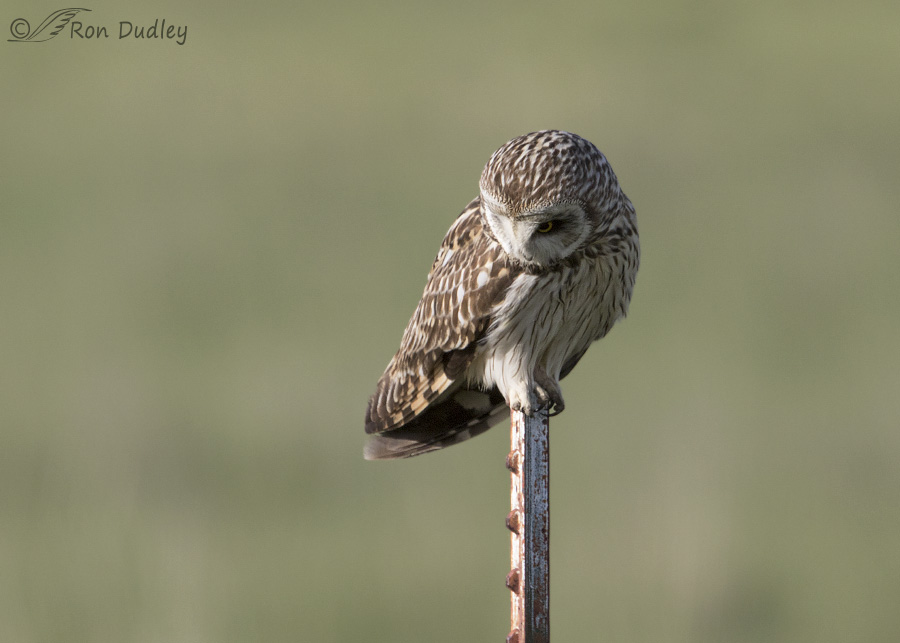
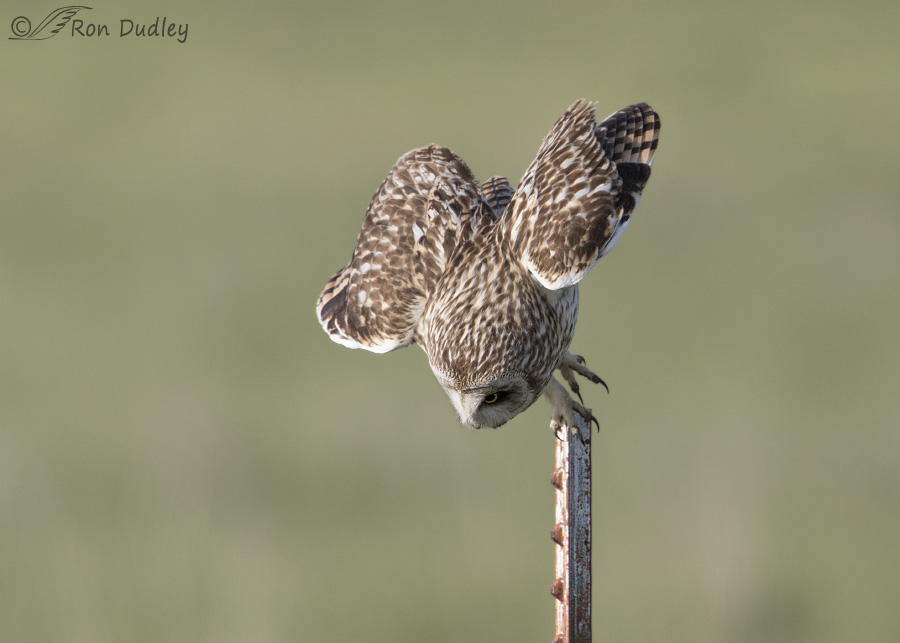
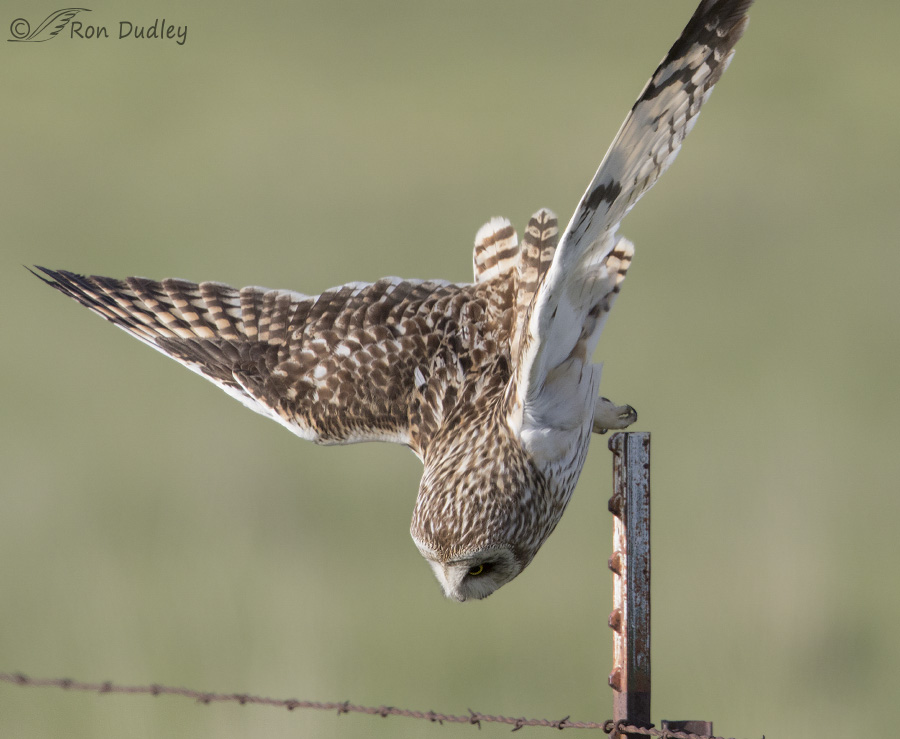
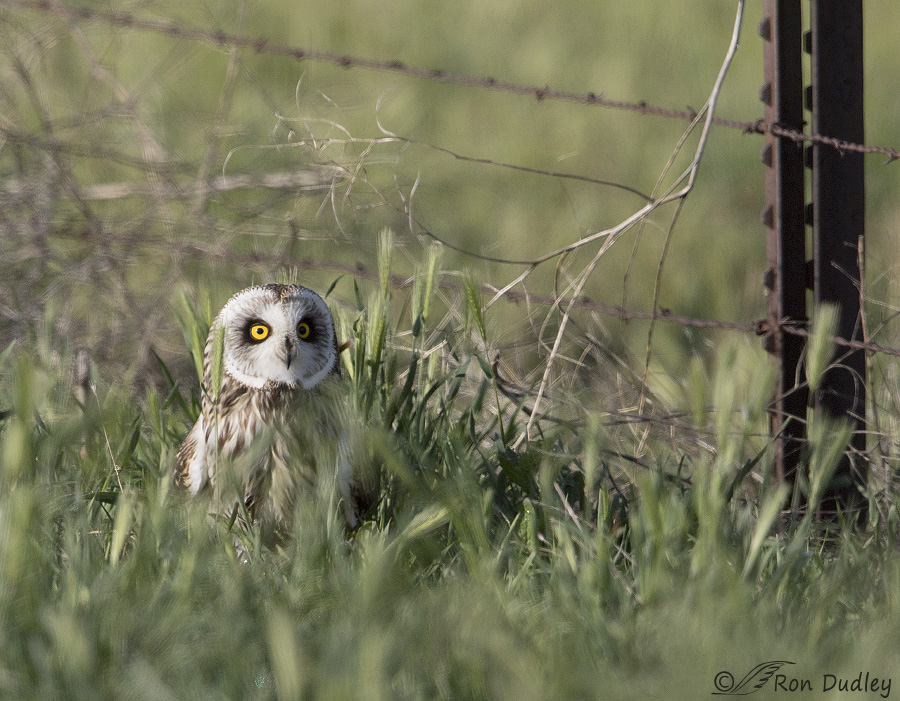
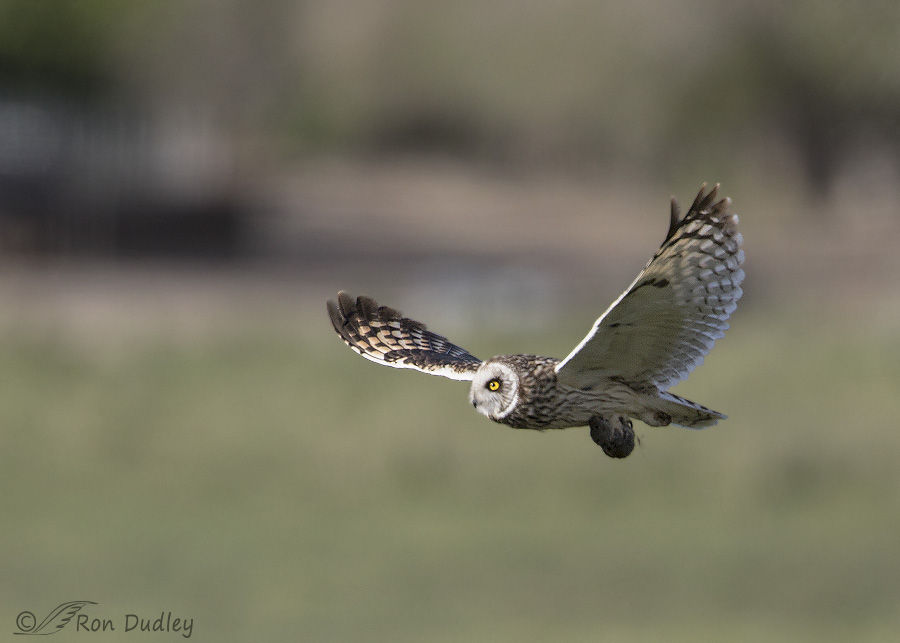
Well, I think they are amazing shots, thank you Ron! Not often do you see one head first diving so close like that. I am glad he caught the vole and did not hit the wire. This made me think also about the hawks that have snakes dangling from their talons here. I was just informed we have rattlesnakes here now. What prevents a hawk from getting bit by a rattlesnake when trying to capture it? That seems real dangerous to me.
Thanks, Barby. I’m not sure anything would prevent it, Barby. The feathers might be a little difficult for the fangs to penetrate but I don’t know that for sure.
Hi Barby. I don’t know if owls employ this strategy (or if they choose to mess with snakes that are bigger than they are at all), but here’s a National Geographic video of a redtail and a rattler, the redtail acting as a matador, offering its primaries to the snake until it’s safe to strike the snake’s head. Redtail v. Rattlesnake (NatGeo video): http://youtu.be/hjmJla-q880
That was an interesting clip, Laura.
However…., things don’t always go that well for the raptor, even if the snake is relatively small and non-venomous. Check this out – it has a happy ending, for the Red-tail if not for the Gopher Snake (Bull Snake), but it was a hell of a close call.
http://www.youtube.com/watch?v=hV0cMf61urs
The video isn’t playing right now. My Internet provider has issues. I’ll try again tomorrow or maybe try another browser.
ANYWAY, Mariah and I had an encounter with a bull snake in Wyoming in either 2001 or 2002. She crashed down on something, but I didn’t hear anything to indicate that she’d caught it. So I kept on walking, expecting her to rejoin me in a minute or two. When she didn’t, I headed back to the last place I’d seen her to find that she’d caught a bull snake, had it by the head, but the remaining two thirds of that snake was killing her back and had wound its back parts around her neck! I didn’t think about it, but started unwinding it–probably 10 or 12 laps around her neck. Without intervention, I’d guess they both might have died there, each too darn stubborn to let go in the context of discretion and survival.
About a year later, she did the matador dance with a rattler. I did NOT rush in to save her, but watched from a safe distance, terrified how this encounter would end. She missed two or three times, but ultimately grabbed its head. After the bull snake, I asked my favorite raptor vet what the specific dangers to her were and was told that she’d be good eating the venom, but if the snake bit her (penetrated the feathers), it would likely kill her. She’d deflected direct attacks and finally subdued the thing, so I let her kill it–that took a while.
Interestingly, after that, she left snakes alone. She ate the leftovers of the bull snake but refused the rattler leftovers. Guess they’re not a tasty treat in redtail land??
“I was told that she’d be good eating the venom”.
Laura, Snake venom is a protein and proteins are digested (broken down chemically) by vertebrate digestive systems, rendering them harmless when they’re swallowed.
It’s when protein venoms are injected by fangs, bypassing digestion, that they can be lethal.
The link to the video is working for me so I’m not sure what’s going on at your end…
Having spent the last two years pursuing voles with Jack the Harris’ hawk, I can attest to just how invisible they are in their environment. It takes a raptor’s eye to see them for the nanosecond they’re visible before they disappear into their pathways in the grasses. They’re shifty little goobers, but Jack says they’re tasty treats I think I’ll pass for the foreseeable future.
I think I’ll pass for the foreseeable future.
I can’t believe how hard voles are to see, Laura. They’re so damned quick, they don’t like to be out in the open (for obvious reasons) and their coloration is cryptic in most environments.
The best looks, by far, I’ve had of voles have always been when they’re already in the clutches of a raptor!
“In the clutches of a raptor” is likely to be the best ever look at a vole! And by the time you get the camera up, they will have skedaddled smartly some other where!
Don’t just “pass”… If you don’t try one, you’ll never know….
Is this the voice of experience? Do they taste like chicken?
Nope Marty, I hold out for the good stuff. After you gut them, there’s not much left.
Well…., don’t gut them then!
You replied, “don’t gut them then.” And maybe mix them with a bit of chianti? LOL! Actually, by the time I got to Jack, he’d already gobbled his voles down–a tasty treat. In my new place here, we might not even get off my property before Jack catches a cottontail, quail or jackrabbit. All we have to do is walk out the front door! Sometimes, they’re in my back yard, too. That will make Jack a happy boy!
The owl’s persistence, and your persistence were both rewarded.
As we were.
Thanks, EC.
This Owl is clearly highly skilled at doing whatever is needed to catch prey. This maneuver may not be quite as artistic as the other, but it’s still quite spectacular. Since I don’t have the opportunities to watch Owls hunt, this series and the last one are very good lessons in what birds are capable of doing.
Thank you, Susan.
I cheered out loud at the shot with the vole and woke the dog! These are fabulous action shots, Ron. You are a master of capture! I had no idea that SEOs could dive bomb from a perch like that. Show me a few more series like this one and SEOs will pass GHOs as my favorite owl species.
The thought of you cheering made me smile, Marty. I VERY nearly didn’t include that last shot and just told my readers about it instead because it’s so soft – especially before I processed it. It was a last second decision to include it and now I’m glad I did. Happy endings are always nice…
I’m so glad that you did include that last shot. He looks a little like a WWII bomber.
Plus, what you call “soft,” the rest of us would give our eyeteeth for.
I know you hate those metal posts almost as much as I hate, I hate ,hate Devil wire, but I really like the way the colors of the post echo the colors of the bird! It looks like persistence paid off for both of you….I love these birds!!!
I hadn’t noticed that similarity between the colors of the post and bird, Patty. You’re right!
Beautiful images, Ron. Spectacular light, razor sharp focus. Wonderful!
Thank you, Dan.
Wonderful shots Ron!
Don’t voles use a fence line and posts for protection? Run their grass runways along the fence line and venture out from the fence line?
If only the wire didn’t have barbs we could all breath a sigh of relief.
Thanks, Dick. If voles do what you’ve described it’s news to me. I have no idea…
In some ways it makes sense but on the other hand it would make them sitting ducks for raptors hunting from posts.
Ron, another series of great shots that allows us to briefly experience the lives of these magnificent animals. Don’t be so hard on yourself if your shot clips a wing or has a modest amount of softness, which most do not! It has no impact on our enjoyment of your work. Those of us who try to get similar shots in our part of the country know how difficult it is to get the perfect shot. Thanks for sharing your work.
Thanks for the encouragement, Reid. To be honest I was quite happy to get that 4th shot sharp without clipping anything more than just the end of the left wing. And we can even see his left eye which was a bonus in this situation.
WOW! That was an impressive maneuver off the fence post! Playing with fire with the barbed wire there tho obviously has that figured out! Glad you caught the action and the owl was finally successful.
Judy, it always makes me nervous to see them so close to the wire but usually the adults are skillful and savvy enough to avoid tangling with it. It’s the young birds I worry about most…